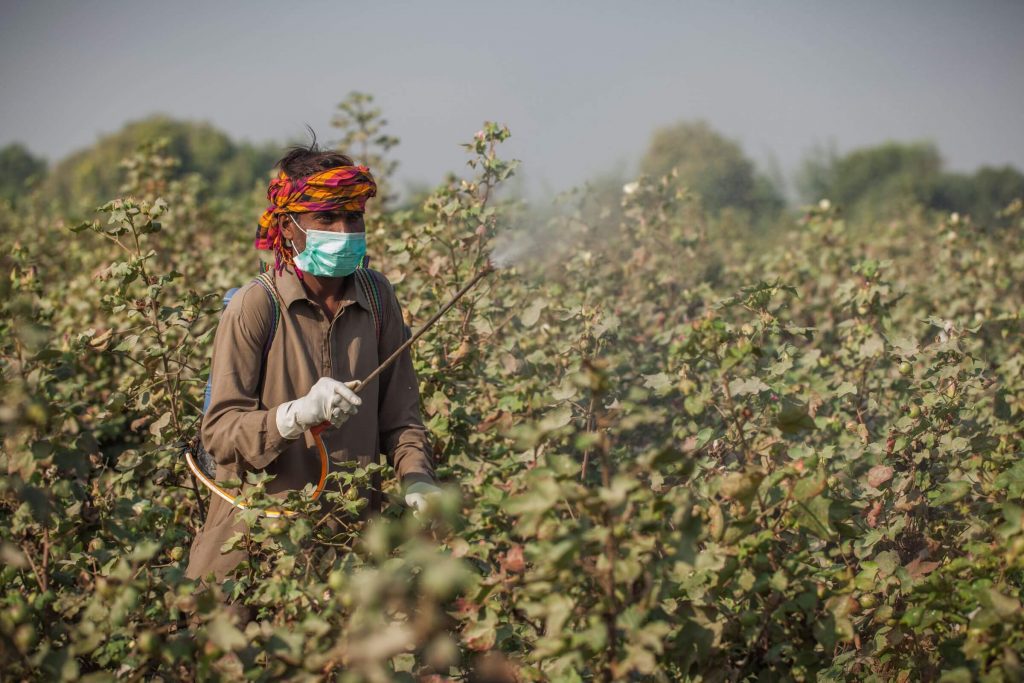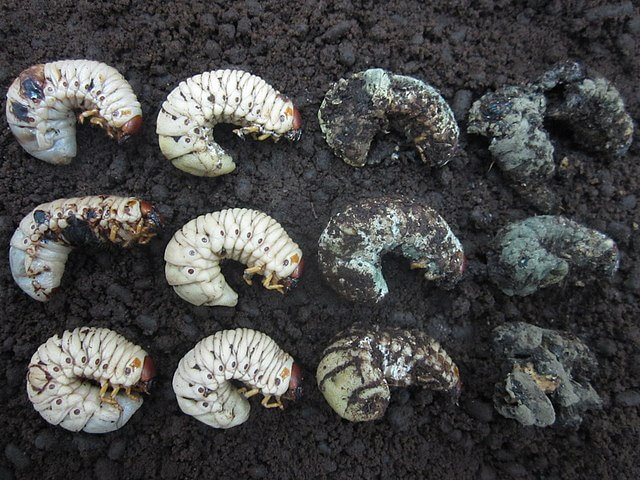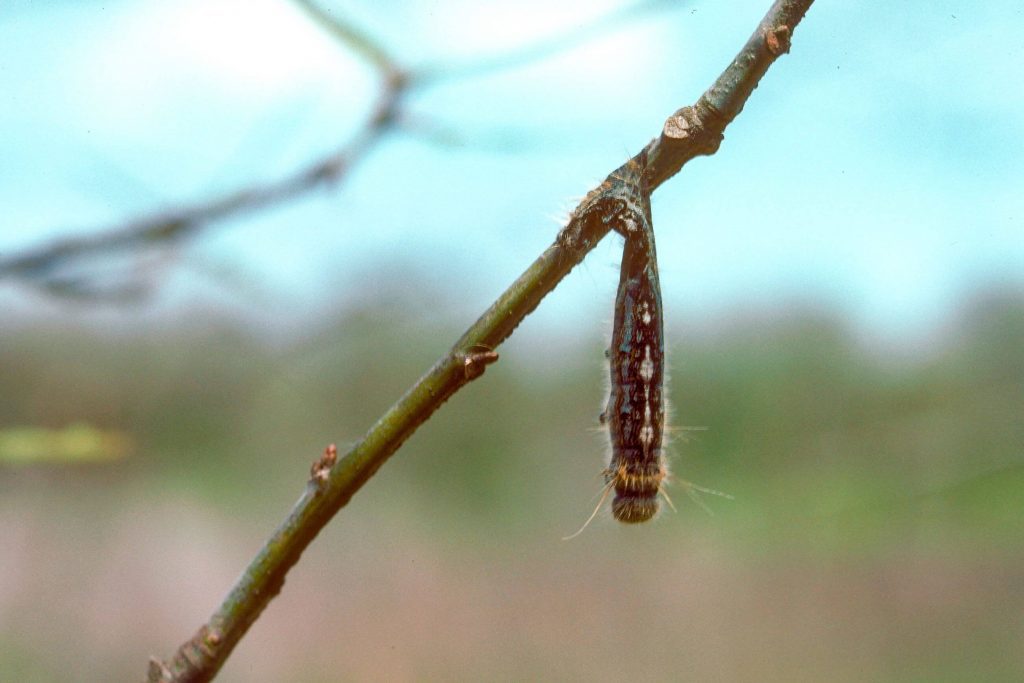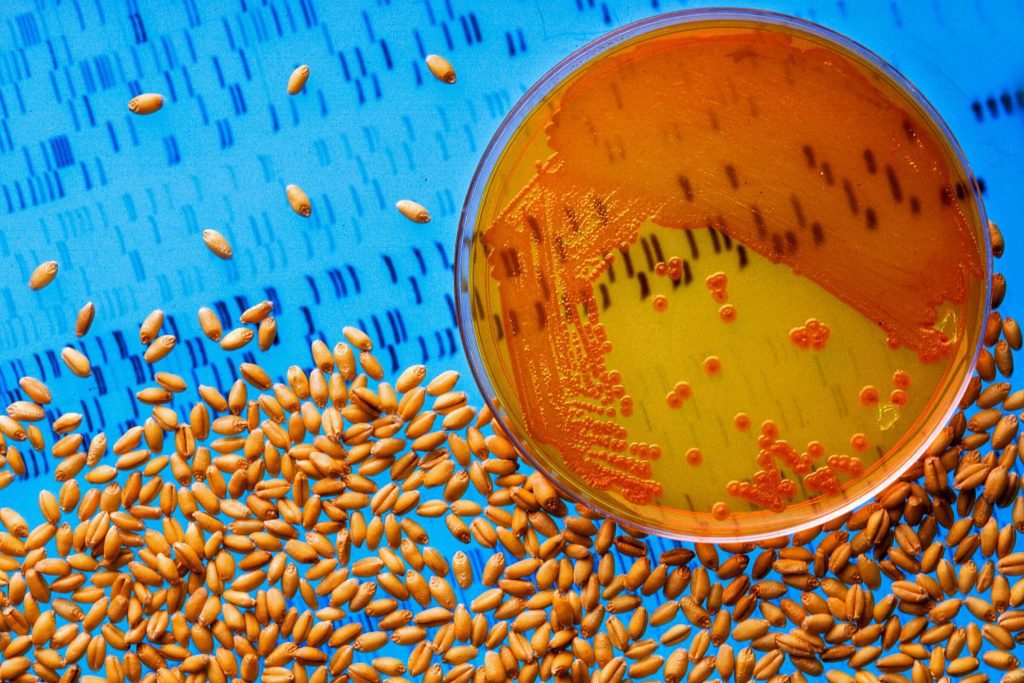Overview
- What are microbial biopesticides?
- Types of microbial biopesticides
- How do they work: modes of action
- How are they applied?
What are microbial biopesticides?
Microbial biopesticides, or microbials, are biological control products that contain microscopic living organisms (or their by-products) as the main active ingredient.
The application of microbial biopesticides is similar to other pest control products – such as with a spray bottle, in the soil, or on foliage, to name a few examples.
Some examples of microbial pesticides are:
- BETK-03®(BETK-03® CL, BETK-03® PE)
- Serenade® (BR)
- BioCeres EC®(US, CA)
- Attracap® (DE)
- Capex® (FR, GB)
- Nexy® (FR, US)
- V10® (DE, GB, CA, ES)
Microbial biopesticides are just one type of biocontrol agent. There are others, such as:
Microbial biopesticides are typically based on viruses, bacteria or fungi, but they can also contain oomycetes or algae.
We can separate microbials into two groups based on their functionality:
- antagonist microbials – microbials that control diseases
- entomopathogenic microbials – microbials that control insect pests

Types of microbial biopesticides
Bacterial biopesticides
Bacterial biopesticides are the most common and used form of microbial biological control. Growers mainly use them to fight insect pests such as moths, caterpillars, beetles and flies.
Entomopathogenic bacteria
Bacterial biopesticides are often applied directly to the crop. Once ingested by an insect pest, it infests its host. The bacteria release toxins inside the insect that attack gut cells, perforating the insect’s gut. The insect dies within a couple of days.
Common entomopathogenic biopesticides contain the bacteria of the genus Bacillus.
- For example, BETK-03® (CL, PE) is a wettable powder that contains bacteria from the Bacillus thuringiensis (var. Kurstaki) species. The powder is mixed with water and sprayed on foliage attacked by the pest. This product targets caterpillars of butterflies and moths (Lepidopteran), including the tomato leaf miner (Tuta absoluta), the oriental fruit moth (Cydia molesta) and the codling moth (Cydia pomonella). When caterpillars ingest the product, the bacteria act on the insect’s gut, leading to its paralysation. Caterpillars can no longer feed and eventually die.
Antagonist bacteria
Bacillus bacteria are also common in products that target soil and plant leaf (foliar-borne) diseases. They can prevent and control diseases through various mechanisms, such as competition and antibiosis.
- For example, the Serenade® (BR) biopesticide contains the bacterial species Bacillus subtilis. It limits the growth of numerous foliar-borne pathogens, such as the ones causing powdery mildew, early blight, botrytis and more. It works by antibiosis, meaning that the bacteria produce inhibiting compounds that limit the growth of the pathogen.
Fungal biopesticides
Entomopathogenic fungi
Fungal biopesticides enter insect pests’ bodies once they come into contact. The fungus multiplies inside the insect, paralysing it via toxin production and then eventually killing it. Four genera are common amongst the entomopathogenic fungi: Beauvaria, Isaria, Metarhizium and Paecilomyces.


- BioCeres EC®(US, CA) is a biopesticide that contains spores of the Beauvaria bassiana fungus. It targets pests such as whiteflies, thrips and aphids. Once sprayed on the insects, it infects them and, after a few days, causes mortality.
- Attracap® (DE) is a fungal product that attacks wireworms (larvae of click beetles) that damage potatoes. This product is in the form of granules that contain fungal spores of Metarhizium brunneum. The granules attract wireworms in the soil. Once the wireworms reach the granules, they die within a few days.
Antagonist fungi
Many fungal products targeting diseases contain fungi from the genus Trichoderma spp.. They work against root pathogens such as Fusarium root rot and powdery mildew.
Some products like Nexy® (FR, US) contain yeasts that will compete with plant pathogens for nutrients. It is active against the grey mould (Botrytis spp.) or some pathogenic Penicillium species.
Afla-Guard GR® (US) is another fungal biopesticide that outcompetes and controls a pathogenic fungus growing in maize.
Viral biopesticides
Entomopathogenic viruses
Insects need to eat the virus before it can take effect. Insects ingest the virus by feeding on the plant where the product has been applied. The virus then infects the insect’s gut and spreads through the insect, which dies in a couple of days. Once the insect dies, its body eventually bursts and releases the virus into the environment, which can infect new hosts.


Viral biopesticides typically contain baculoviruses. Nucleopolyhedrosis viruses (NPVs) and Granuloviruses (GVs) are the most frequently used genera of Baculoviruses.
For example, Capex® (FR, GB) is a product based on a granulovirus that works against the summer fruit tortrix (Adoxophyes orana), a pest that feeds on various fruit crops.
Cryptex® (KE, UG) is another viral product that controls the false codling moth (Thaumatotibia leucotreta) in citrus fruits.
Antagonist viruses
Some viruses can tackle plant diseases by improving the plant’s ability to fight pathogens, including other viruses.
This is the case for the V10® (DE, GB, CA, ES) biopesticide, a viral biopesticide that controls the Pepino Mosaic Virus (PepMV) in tomatoes. This product works like a vaccine for the plant. The virus contained in the product is the same virus that attacks the plants but is a less virulent variant. You can use this product preventively and help the plant “prepare” for an eventual attack from a harmful virus variant.
How do they work: modes of action
The effect and modes of action of a microbial biopesticide depend on the targeted pest or disease and the microorganism contained in the product.
- Entomopathogenic microbes can work against insect and mite pests. Typically, insects get infected by either eating (ingestion) of microbes or by the penetration of microbes through their skin (cuticle). Insects can die from either direct infection or from toxins released.
- Microbial antagonists control plant disease, both above and below ground and do so in several ways, such as:
- Competition (or competitive exclusion): the antagonist can compete with the plant disease for food or space, eventually outcompeting it. This works well against fungal pathogens that colonize plant roots.
- Parasitism: the antagonist “eats” the pathogen. For example, some fungi can gain nutrients from other fungi and thereby limit the growth of the disease.
- Antibiosis (or the production of inhibiting products): the antagonist limits or reduces the growth of the pathogen by producing inhibitory compounds.
- Induction of plant resistance: the antagonist can improve the ability of the plant to fight diseases. The application must precede the detection of the disease. For example, using seed treatment products.
How can microbial biopesticides be applied?
There are many ways of applying microbial biopesticides to the target pests. The application method depends on the active ingredient (bacteria, fungi, viruses, etc.), the target pest or disease and the formulation of the product.
Microbial biopesticides come in various formulations, including wettable powders (WP), water-dispersible granules (WDG) and suspension concentrates (SC). Liquid formulations tend to be sprayed or incorporated into the irrigation system, for example. Microbials can be delivered to the seeds, soil, cuttings, seedlings or maturing/mature plants.


Some application methods include:
- Seed treatment: the microbial biopesticide is applied to seeds before sowing. It prevents pathogens from colonizing the roots and protects the crop during its early stages. You can dip the seeds in the microbe or sprayed with it.
- Seedling dipping: you can dip seedlings or roots of seedlings in a mixture containing the microbial product.
- Soil application: the microbial biopesticide can be applied directly in the soil to control soil-borne diseases and root pests. You can incorporate the product into the soil as is (for example, granules) or mixed with water first.
- Foliar spray application: the product is directly sprayed on plant leaves, targeting foliar diseases and pests feeding on the plant’s top parts. With this method, you must pay attention to environmental conditions, such as rain, UV rays and temperature, which can significantly impact a product’s efficacy.
For the next step, take a look at our blog:
